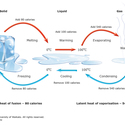Limestone is a very common sedimentary rock consisting of more than 50% calcium carbonate. Although it occurs in many different forms, its origins can be traced back to either chemical or biochemical processes that occurred in the geological past, often tens to hundreds of millions of years ago.
Biochemical limestones
Many different types of marine organisms have developed the ability to precipitate calcium carbonate from seawater to serve as a protective shell or exoskeleton. For example, scallops have a two-piece outer shell that can be opened to allow the scallop to feed and closed to give protection, whereas bryozoans produce an outer casing within which they can live.
When these organisms die, their shells accumulate on the seafloor. The soft parts decay, leaving only the hard shells (exoskeletons or tests), which typically become broken down by current action and biological predators. Over long periods of time, the loose skeletal sediments are transformed into bioclastic limestone by the addition of a chemically precipitated carbonate cement between the shell fragments. In the warm low-latitude waters of the tropics, these are called tropical bioclastic limestones, while in the cooler waters, at mid to high latitudes, they are known as temperate bioclastic limestones.
In the case of large congregations of tropical marine organisms, like reef-building corals, the normally very large structure remains intact as it is transformed into tropical limestone reef rock.
Lithification – from sediment to rock
Converting accumulated cool-water shell sediments into rock consists of several steps. Firstly, the shell fragments are slowly compacted as the weight of the accumulating sediment increases. Compaction forces the shell fragments closer together, reducing the space between the fragments and driving off some of the contained water. Some of this water may be rich with dissolved calcium carbonate, and this may later precipitate as calcite cement crystals in the pore spaces. Gradually, the fragments are cemented together, completing the second step in the process. Finally, further compaction and burial may cause some alteration or recrystallisation of the calcite to make the rock even harder.
In the warm-water tropical setting, deep compaction of the sediments is not required to cement them. Here, the waters are supersaturated in calcium carbonate, which precipitates out of solution as crystals of aragonite cement, binding the shell material together.
Chemical limestones
Some limestones are formed by direct chemical precipitation from marine and other waters saturated with calcium carbonate. If carbon dioxide is removed from this water by warming, agitation or photosynthesis, there is a tendency for calcium carbonate to be precipitated. For example, the beach rock commonly found along tropical beaches is a limestone that has been formed in the intertidal zone in this way. Some limestones are formed in freshwater environments associated with caves (stalactites and stalagmites), springs (tufa and travertine) and lakes.
Stalactites and stalagmites form in caves as water evaporates from calcium carbonate-rich waters that drip from the roof of the cave and onto the floor. Travertine forms as a result of calcium carbonate precipitation from ground and surface waters and especially geothermal waters.
Oolites (or ooids) are small rounded spheres of calcium carbonate that form in warm, supersaturated, shallow, highly agitated tropical marine water. The oolites form by chemical precipitation of a layer of aragonite crystals about some hard particle – often a shell fragment. Strong currents continually shift the oolites around so that new concentric layers of aragonite grow on top of the earlier layers. The oolites are alternately exposed to pick up a concentric layer and then buried to set the layer.
Metamorphic limestone
If, over time, a body of limestone has been squeezed and deformed by great heat and pressure deep beneath the Earth’s surface, its structure and composition changes to form a recrystallised limestone known as marble, which can contain over 95% calcium carbonate. Marble is a hard crystalline rock that takes a high polish and is used for building and sculpture.
Chalk
Chalk is a special form of limestone mainly formed in deeper water from the shell remains of microscopic marine plants and animals such as coccolithophores and foraminifera. Unless deeply buried, most chalks are relatively soft rock with a high calcium carbonate content. The famous White Cliffs of Dover bordering the English Channel consist of chalk deposits.







